Corsair's Force SSD Reviewed: SF-1200 is Very Good
by Anand Lal Shimpi on April 14, 2010 2:27 AM ESTOverall System Performance using PCMark Vantage
Next up is PCMark Vantage, another system-wide performance suite. For those of you who aren’t familiar with PCMark Vantage, it ends up being the most real-world-like hard drive test I can come up with. It runs things like application launches, file searches, web browsing, contacts searching, video playback, photo editing and other completely mundane but real-world tasks. I’ve described the benchmark in great detail before but if you’d like to read up on what it does in particular, take a look at Futuremark’s whitepaper on the benchmark; it’s not perfect, but it’s good enough to be a member of a comprehensive storage benchmark suite. Any performance impacts here would most likely be reflected in the real world.
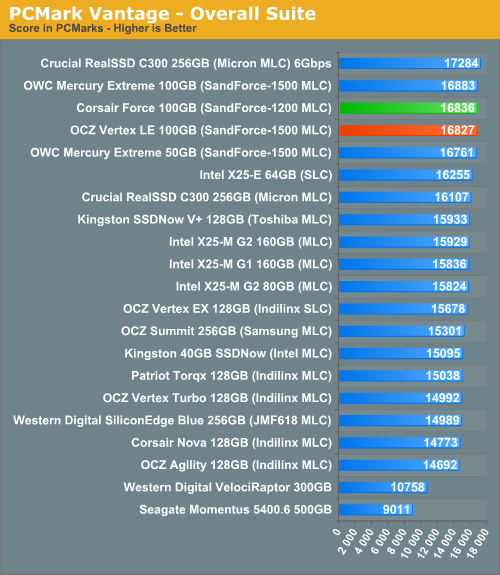
Real world performance is very competitive. Corsair's Force is easily in the top 3 for best performing SSDs on the market today.
The memories suite includes a test involving importing pictures into Windows Photo Gallery and editing them, a fairly benign task that easily falls into the category of being very influenced by disk performance.
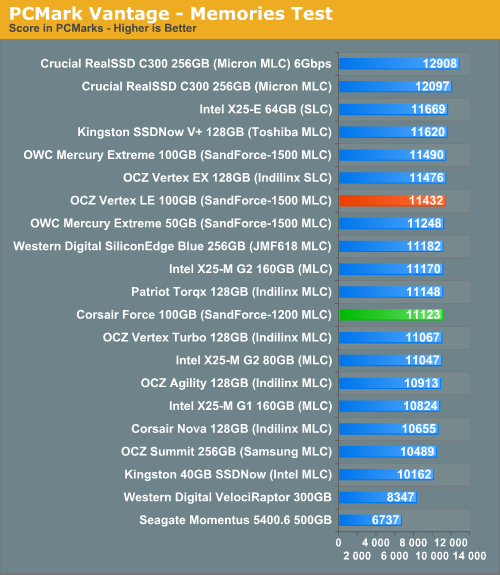
The TV and Movies tests focus on on video transcoding which is mostly CPU bound, but one of the tests involves Windows Media Center which tends to be disk bound.
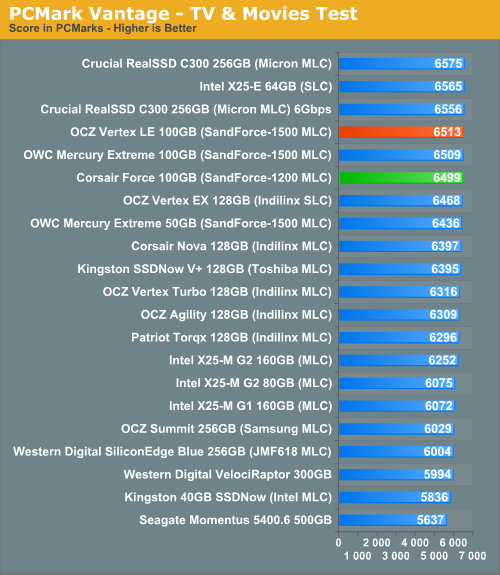
The gaming tests are very well suited to SSDs since they spend a good portion of their time focusing on reading textures and loading level data. All of the SSDs dominate here, but as you'll see later on in my gaming tests the benefits of an SSD really vary depending on the game. Take these results as a best case scenario of what can happen, not the norm.
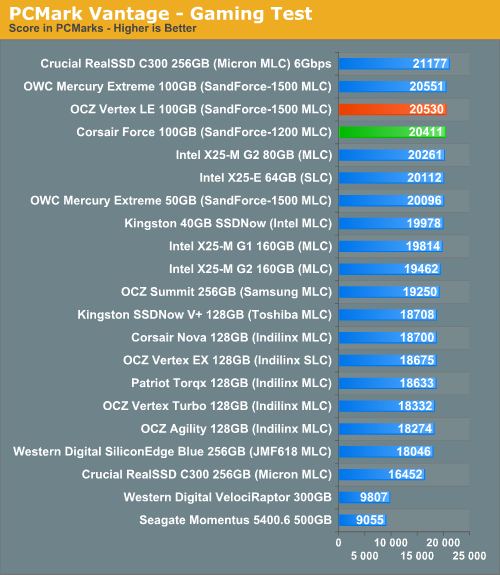
In the Music suite the main test is a multitasking scenario: the test simulates surfing the web in IE7, transcoding an audio file and adding music to Windows Media Player (the most disk intensive portion of the test).
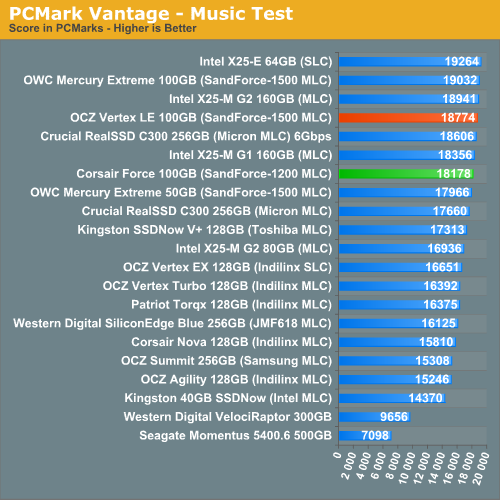
The Communications suite is made up of two tests, both involving light multitasking. The first test simulates data encryption/decryption while running message rules in Windows Mail. The second test simulates web surfing (including opening/closing tabs) in IE7, data decryption and running Windows Defender.
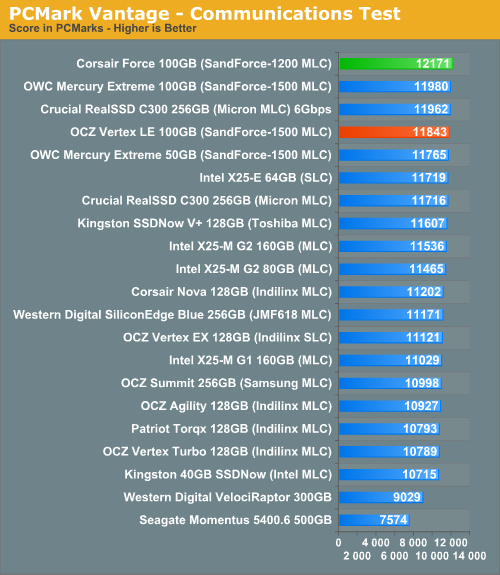
I love PCMark's Productivity test; in this test there are four tasks going on at once, searching through Windows contacts, searching through Windows Mail, browsing multiple webpages in IE7 and loading applications. This is as real world of a scenario as you get and it happens to be representative of one of the most frustrating HDD usage models - trying to do multiple things at once. There's nothing more annoying than trying to launch a simple application while you're doing other things in the background and have the load take forever.
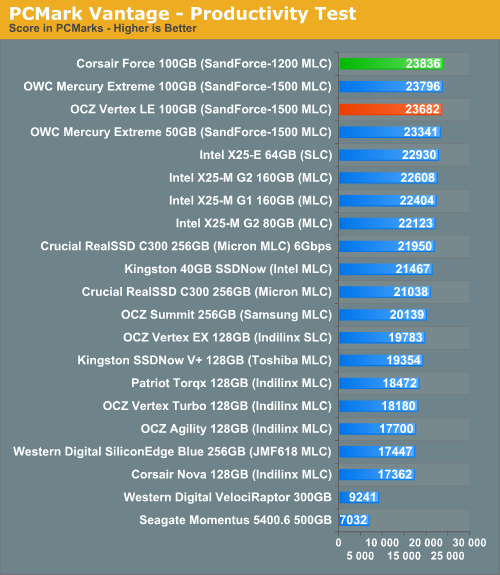
The final PCMark Vantage suite is HDD specific and this is where you'll see the biggest differences between the drives:
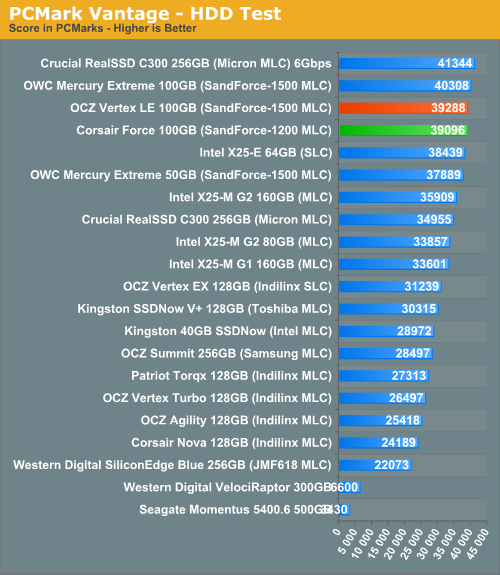










63 Comments
View All Comments
Anand Lal Shimpi - Wednesday, April 14, 2010 - link
That I'm not sure of, the 2008 Iometer build is supposed to use a fairly real world inspired data set (Intel helped develop the random algorithm apparently) and the performance appears to be reflected in our real world tests (both PCMark Vantage and our Storage Bench).That being said, SandForce is apparently working on their own build of Iometer that lets you select from all different types of source data to really stress the engine.
Also keep in mind that the technology at work here is most likely more than just compression/data deduplication.
Take care,
Anand
keemik - Wednesday, April 14, 2010 - link
Call me anal, but I am still not happy with the response ;)Maybe the first 4k block is filled with random data, but then that block is used over and over again.
That random read/write performance is too good to be true.
Per Hansson - Wednesday, April 14, 2010 - link
Just curious about the missing capacitor, will there not be a big risk of dataloss incase of power outage?Do you know what design changes where done to get rid of the capacitor, where any additional components other than the capacitor removed?
Because it can be bought in low quantities for a quite ok retail price of £16.50 here;
http://www.tecategroup.com/ultracapacitors/product...
bluorb - Wednesday, April 14, 2010 - link
A question: if the controller is using lossless compression in order to write less data, is it not possible to say that the drive work volume is determined by the type of information written to it?Example: if user x data can be routinely compressed at a 2 to 1 ratio then it can be said that for this user the drive work volume is 186GB and cost per GB is 2.2$.
Am I on to something or completely of the track ?
semo - Wednesday, April 14, 2010 - link
this compression is detectable by the OS. As the name suggests (DuraWrite) it is there to reduce the wear on the drive which can also give better performance but not extra capacity.ptmixer - Wednesday, April 14, 2010 - link
I'm also wondering about the capacity on these SandForce drives. It seems the actual capacity is variable depending on the type of data stored. If the drive has 128 GB of flash, 93.1 usable after spare area, then that must be the amount of compressed/thinned data you can store, so the amount of 'real' data should be much more.. thereby helping the price/GB of the drive.For example, if the drive is partly used and your OS says it has 80 GB available, then you store 10 GB of compressible data on it, won't it then report that it perhaps still has 75 GB available (rather than 70 GB as on a normal drive)? Anand -- help us with our confusion!
ps - thanks for all the great SSD articles! Could you also continue to speculate how well a drive will work on a non trim-enabled system, like OS X, or as a ESXi Datastore?
JarredWalton - Wednesday, April 14, 2010 - link
I commented on this in the "This Just In" article, but to recap:In terms of pure area used, Corsair sets aside 27.3% of the available capacity. However, with DuraWrite (i.e. compression) they could actually have even more spare area than 35GiB. You're guaranteed 93GiB of storage capacity, and if the data happens to compress better than average you'll have more spare area left (and more performance) while with data that doesn't compress well (e.g. movies and JPG images) you'll get less spare area remaining.
So even at 0% compression you'd still have at least 35GiB of spare and 93GiB of storage, but with an easily achievable 25% compression average you would have as much as ~58GiB of spare area (45% of the total capacity would be "spare"). If you get an even better 33% compression you'd have 66GiB of spare area (51% of total capacity), etc.
KaarlisK - Wednesday, April 14, 2010 - link
Just resize the browser window.Margins won't help if you have a 1920x1080 screen anyway.
RaistlinZ - Wednesday, April 14, 2010 - link
I don't see a reason to opt for this over the Crucial C300 drive, which performs better overall and is quite a bit cheaper per GB. Yes, these use less power but I hardly see that as a determining factor for people running high-end CPU's and video cards anyway.If they can get the price down to $299 then I may give it a look. But $410 is just way too expensive considering the competition that's out there.
Chloiber - Wednesday, April 14, 2010 - link
I did test it. If you create the test file it compressable to 0 percent of its original size.But if you write sequential or random data to the file you can't compress it at all. So i think that iometer uses random data for the tests. Of course this is a critical point when testing such drives and I am sure that anand did test it too before doing the tests. I hope so at least ;)